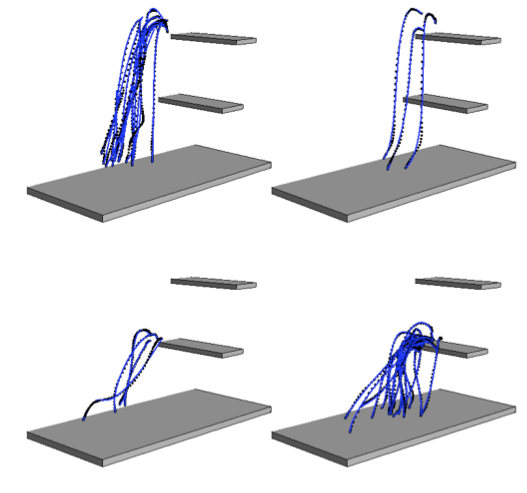Findings
Modeling Foot Motions in Ingress
Reed, M.P., Hoffman, S.G., and Ebert-Hamilton, S.M. (2010). Modeling foot trajectories for heavy truck ingress simulation. Proceedings of the Applied Human Factors and Ergonomics Conference, Miami, FL.
Objective: Quantify the patterns of motion of the feet during ingress using functional analysis techniques
Method: The analysis presented here focuses on the right and left foot moving from the ground to either the first or second step. The trajectory of each foot was modeled using the translation of single lateral ankle marker on each foot. Some participants placed their right foot on the first step from the ground, while others used the left foot. Left and right-foot trajectories were analyzed separately for analysis in each step condition. Data from 15 subjects were used for this analysis.
Foot trajectories were modeled using a three-step process. The movement from the ground to the first or second step was extracted from the trial data by an automated algorithm that identified segments between stationary periods based on speed. The extracted motions, consisting of between 30 and 80 frames, were resampled using local linear interpolation to obtain 100 evenly spaced points.
Third-order Bézier curves were fit to each trajectory using a least-squares algorithm with adaptive knot assignment. The third-order Bezier curve parameterizes the trajectory into two end points and two interior control points. Regression analyses were conducted to determine the effects of subject and step-location variables on the control point locations.
Results: Out of a possible 280 foot motions (8 step conditions x 15 subjects x 2 feet + 4 step conditions x 5 subjects x 2 feet), 8 trials were excluded due to movement anomalies (e.g., slipping off of the step), leaving 272 trials for analysis. Table 7 shows the distribution of foot motions by the target step. The most common movement pattern (70% of the trials) was moving the right foot to the first step followed by moving the left foot to the second step. The left foot moved to the first step in only 30% of trials.
Key Findings:
• Driver foot trajectories can be accurately modeled using Bézier curves.
• After accounting for the overall displacement of the first foot motion to the first or second step, the shape of the trajectory is affected by stature and BMI, but not by step configuration.
• These results indicate that functional approaches to modeling ingress motions are likely to be successful. The resulting models are designed for use with the Human Motion Simulation Framework, a software system previously applied to simulating a wide range of task-oriented human behavior, including passenger car ingress and egress.

©2017 University of Michigan